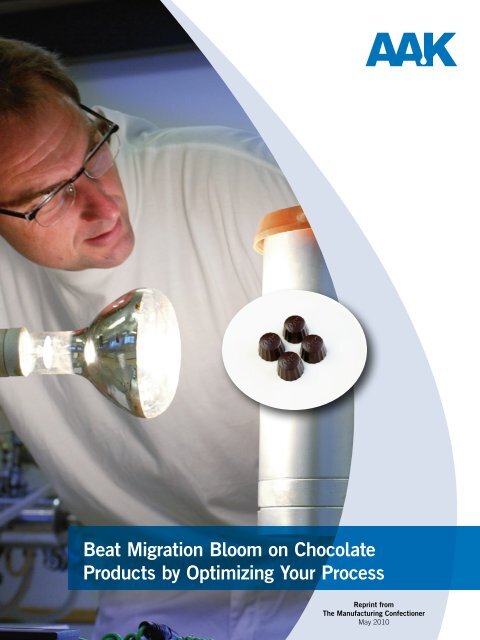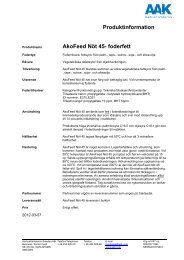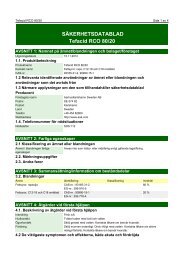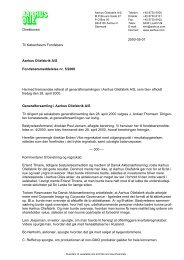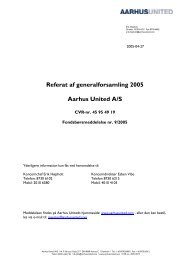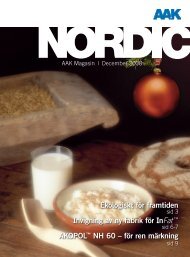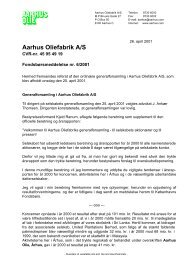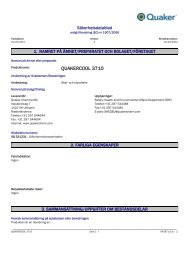Beat Migration Bloom on Chocolate Products by Optimizing ... - AAK
Beat Migration Bloom on Chocolate Products by Optimizing ... - AAK
Beat Migration Bloom on Chocolate Products by Optimizing ... - AAK
You also want an ePaper? Increase the reach of your titles
YUMPU automatically turns print PDFs into web optimized ePapers that Google loves.
<str<strong>on</strong>g>Beat</str<strong>on</strong>g> <str<strong>on</strong>g>Migrati<strong>on</strong></str<strong>on</strong>g> <str<strong>on</strong>g>Bloom</str<strong>on</strong>g> <strong>on</strong> <strong>Chocolate</strong><br />
<strong>Products</strong> <strong>by</strong> <strong>Optimizing</strong> Your Process<br />
Reprint from<br />
The Manufacturing C<strong>on</strong>fecti<strong>on</strong>er<br />
May 2010
<str<strong>on</strong>g>Beat</str<strong>on</strong>g> <str<strong>on</strong>g>Migrati<strong>on</strong></str<strong>on</strong>g> <str<strong>on</strong>g>Bloom</str<strong>on</strong>g> <strong>by</strong><br />
<strong>Optimizing</strong> Your Process<br />
A new look at the tempering process to reduce migrati<strong>on</strong> bloom<br />
in chocolate products.<br />
Bjarne Juul<br />
<strong>AAK</strong><br />
Intensive research has shown a significant<br />
correlati<strong>on</strong> between process parameters and<br />
the speed of migrati<strong>on</strong> bloom development.<br />
It seems that the temperature used for most<br />
temper tests in the world is too low and actually<br />
guides chocolate manufacturers to produce<br />
slightly undertempered chocolate.<br />
The cooling of chocolate and particularly<br />
chocolate shells is too severe, causing too high<br />
cooling rates, which probably affect the ratio of<br />
Form IV and Form V polymorphs in the final<br />
chocolate product.<br />
The subsequent transformati<strong>on</strong>, from Form<br />
IV to Form V, accelerated <strong>by</strong> the migrating oils<br />
from fillings, speeds up the bloom-develop-<br />
ment process.<br />
It is found that if this transformati<strong>on</strong> takes<br />
place at a temperature above room tempera-<br />
ture, a type of heat treatment or “aftertemper-<br />
ing” occurs, and the development of migrati<strong>on</strong><br />
bloom can be delayed significantly.<br />
This heat treatment is applicati<strong>on</strong>- and reci-<br />
pe-dependent and the total treatment is a mul-<br />
tiple of time and temperature.<br />
BACKGROUND<br />
Cocoa butter and cocoa butter equivalents<br />
(cbes) are polymorphic fats (Figure 1). Their<br />
solid stability increases with increasing melt-<br />
ing temperature, but Form V is actually stable<br />
enough in practice for chocolate producti<strong>on</strong><br />
and is easy to make and has a perfect melting<br />
point.<br />
<strong>Chocolate</strong> prefers to crystallize in Forms III<br />
and IV, but <strong>by</strong> using tempering equipment to<br />
make the right combinati<strong>on</strong> of time, shear and<br />
cooling c<strong>on</strong>diti<strong>on</strong>s for a certain fat phase com-<br />
positi<strong>on</strong>, it is possible to make seeds in Form V<br />
in a partly melted chocolate dispersi<strong>on</strong>.<br />
Different types of tempering equipment or<br />
seed techniques have been developed.<br />
Polymorphs of Cocoa Butter<br />
Form Melting point °C<br />
Systematic<br />
Nomenclature<br />
I 17.3 γ<br />
II 23.3 α<br />
III 25.5 β’2<br />
IV 27.5 β’1<br />
V 33.8 β2<br />
VI 36.5 β1<br />
Figure 1<br />
Bjarne Juul is<br />
senior technology<br />
specialist at <strong>AAK</strong>.<br />
He started there in<br />
1991.<br />
Reprint from The Manufacturing C<strong>on</strong>fecti<strong>on</strong>er • May 2010 1
<str<strong>on</strong>g>Beat</str<strong>on</strong>g> <str<strong>on</strong>g>Migrati<strong>on</strong></str<strong>on</strong>g> <str<strong>on</strong>g>Bloom</str<strong>on</strong>g> <strong>by</strong> <strong>Optimizing</strong> Your Process<br />
It appears that<br />
the process is the<br />
major part of many<br />
migrati<strong>on</strong> bloom<br />
problems and this<br />
opini<strong>on</strong> is<br />
supported <strong>by</strong><br />
different<br />
investigati<strong>on</strong>s.<br />
A typical well-tempered chocolate c<strong>on</strong>tains ap-<br />
proximately 2 to 4 percent Form V seed crys-<br />
tals when leaving the tempering unit; the Form<br />
V crystals just survive because of their higher<br />
melting point in this specific fat phase.<br />
An excepti<strong>on</strong> is a new technique that seeds<br />
with approximately 0.5 percent Form VI crys-<br />
tals, which ensures Form V crystallizati<strong>on</strong> in the<br />
remaining 99.5 percent cocoa butter and is sta-<br />
ble enough to induce crystallizati<strong>on</strong> at a slightly<br />
higher temperature.<br />
The purpose of all tempering techniques is<br />
basically to start and ensure the Form V crys-<br />
tallizati<strong>on</strong> in a chocolate. If a chocolate is not<br />
seeded correctly with sufficient Form V crystals,<br />
the chocolate will crystallize in a lower form fol-<br />
lowed <strong>by</strong> transformati<strong>on</strong>, resulting in problems<br />
such as poor c<strong>on</strong>tracti<strong>on</strong> and bloom.<br />
Even producing a well-tempered (Form V)<br />
chocolate does not guarantee that the rest of<br />
the chocolate will crystallize in the same poly-<br />
morphic form. The outcome is highly depend-<br />
ent <strong>on</strong> process cooling and heat treatments.<br />
Too fast a cooling will favor Form IV crystalliza-<br />
ti<strong>on</strong> even if the tempering has created perfect<br />
Form V seeds. Too much heat treatment will<br />
melt the seed.<br />
The applicati<strong>on</strong> has a significant influence<br />
up<strong>on</strong> bloom. For applicati<strong>on</strong>s with <strong>on</strong>ly <strong>on</strong>e fat<br />
phase, such as solid bars or solid pralines, it is<br />
not very critical, whereas for applicati<strong>on</strong>s with<br />
more than <strong>on</strong>e fat phase, like filled bars and<br />
pralines, it is much more critical and much<br />
more difficult to understand.<br />
Applicati<strong>on</strong>s c<strong>on</strong>taining more than <strong>on</strong>e fat<br />
phase c<strong>on</strong>stitute perhaps 90 percent of all<br />
bloom problems and for that reas<strong>on</strong> it is the<br />
most important problem to solve.<br />
It appears that the process is the major part<br />
of many migrati<strong>on</strong> bloom problems and this<br />
opini<strong>on</strong> is supported <strong>by</strong> different investigati<strong>on</strong>s.<br />
2 May 2010 • Reprint from The Manufacturing C<strong>on</strong>fecti<strong>on</strong>er<br />
Tri-unsaturated tri-acylglycerols (TAGs) such as<br />
1-oleoyl-2-oleoyl3-oleoyl-glycerol (OOO) accel-<br />
erate the transformati<strong>on</strong> from Form V to Form<br />
VI and it is very likely that the same will happen<br />
with the Form IV to Form V transformati<strong>on</strong>.<br />
The tri-unsaturated TAG, OOO, is the major<br />
TAG in many nuts, e.g., hazelnut, alm<strong>on</strong>d and<br />
peanut, and all are frequently used in many<br />
fillings in large amounts and migrati<strong>on</strong> bloom<br />
is often seen in this kind of applicati<strong>on</strong>. In this<br />
paper, the focus is <strong>on</strong> the tempering test, tem-<br />
pering and the producti<strong>on</strong> cooling, especially<br />
for shell cooling.<br />
TEMPERING<br />
The traditi<strong>on</strong>al way of tempering is a process<br />
where all the chocolate is cooled to a tempera-<br />
ture where the fat phase starts crystallizing in a<br />
mixture of Forms III, IV and V. This process is<br />
based <strong>on</strong> the possibility of remelting all Form<br />
III and Form IV crystals in a following reheating<br />
z<strong>on</strong>e.Then, <strong>by</strong> testing the tempering curve <strong>on</strong><br />
a standard instrument, it should be possible to<br />
determine the tempering c<strong>on</strong>diti<strong>on</strong>s of the final<br />
chocolate.<br />
It is quite easy to evaluate the slope of a tem-<br />
pering curve but not as easy to evaluate the<br />
plateau level or inflecti<strong>on</strong> point of the curve.<br />
It is found that the plateau is correlated to<br />
the crystal stability and bloom stability of the<br />
chocolate.A lower crystallizati<strong>on</strong> plateau pro-<br />
duces less stable crystals and a less bloom-<br />
resistant chocolate. The target for the inflecti<strong>on</strong><br />
plateau must therefore be as high as possible<br />
for a certain chocolate compositi<strong>on</strong>.<br />
It is well known that the fat phase composi-<br />
ti<strong>on</strong> affects the inflecti<strong>on</strong> point level. More milk<br />
fat in a recipe, for example, produces a lower<br />
inflecti<strong>on</strong> point. This fact does not directly influ-<br />
ence the purity of Form V seed crystals because<br />
it is possible to adjust for it. But when tempering
equipment is unable to make the high inflecti<strong>on</strong><br />
level or there is ignorance about how important<br />
it is or how to change it, then it is much worse<br />
and more difficult to change.<br />
COOLING FOR TEMPER TESTERS<br />
AND SHELL COOLING<br />
Nearly all tempermeters use a cooling tempera-<br />
ture somewhere between +7° and +10°C even<br />
though cocoa butter prefers gentle cooling to<br />
ensure Form V crystallizati<strong>on</strong>. Years ago an ice-<br />
and-water bath was used; this was even further<br />
away from “perfect” chocolate cooling.<br />
Tests carried out in our pilot laboratory <strong>on</strong> a<br />
dark chocolate using a standard tempermeter<br />
have shown a clear correlati<strong>on</strong> between the<br />
chosen cooling temperature <strong>on</strong> the temperme-<br />
ter and the inflecti<strong>on</strong> point level and slope for a<br />
certain chocolate (Figure 2).<br />
From Figure 2 it can be seen that as the cool-<br />
ing temperature in the tempermeter increases<br />
so does the slope.<br />
For example, the 17°C cooling temper ature<br />
gives a slope of +0.41, an indicati<strong>on</strong> of under-<br />
temper, that there is an insufficient quantity of<br />
Form V seed. To correct this, slightly lower cool-<br />
ing temperatures in the crystallizati<strong>on</strong> z<strong>on</strong>es<br />
and slightly less heat in the heating z<strong>on</strong>es of<br />
the temperering unit are needed.<br />
Figure 3 shows the correlati<strong>on</strong> between the<br />
inflecti<strong>on</strong> point for the same chocolate as used<br />
in Figure 2 and the cooling temperature, but<br />
now the tempering unit has been optimized<br />
(see above) for each of the four cooling tem-<br />
peratures <strong>on</strong> the tempermeter.<br />
It seems that increasing the cooling tempera-<br />
ture increases the inflecti<strong>on</strong> point of the choco-<br />
late.That indicates that more stable crystals are<br />
produced at higher cooling temperatures.<br />
In Figure 4 the well-tempered chocolate<br />
from the above tempering-test measurements is<br />
<str<strong>on</strong>g>Beat</str<strong>on</strong>g> <str<strong>on</strong>g>Migrati<strong>on</strong></str<strong>on</strong>g> <str<strong>on</strong>g>Bloom</str<strong>on</strong>g> <strong>by</strong> <strong>Optimizing</strong> Your Process<br />
evaluated. After the tempering test is finished,<br />
the different chocolates are kept for 10 minutes<br />
at 15°C and refined <strong>on</strong> a grater and weighed<br />
into dsc (differential scanning calorimeter)<br />
cups and melted using the following program<br />
<strong>on</strong> a Mettler Toledo DSC 823:<br />
The temperature regime is 2 min. at 15°C<br />
and then 15°C to 60°C at +5°C/min.<br />
Figure 4 shows the correlati<strong>on</strong> between the dsc<br />
peak values for the melting curves and the cool-<br />
ing temperature <strong>on</strong> the Exotherm equipment.<br />
It seems that the higher the cooling tempera-<br />
ture, the higher the peak value, which indicates<br />
a purer Form V crystallizati<strong>on</strong>.<br />
Cooling and Temper Curve Slopes<br />
Temperature curve slope<br />
0.6<br />
0.5<br />
0.4<br />
0.3<br />
0.2<br />
0.1<br />
Figure 2<br />
Correlati<strong>on</strong> of Inflecti<strong>on</strong> Point <strong>on</strong><br />
Optimized Temper Unit<br />
Inflecti<strong>on</strong> point °C<br />
Figure 3<br />
0<br />
7 9 11 13 15 17 19<br />
Cooling temperature °C<br />
26.5<br />
The influence of cooling temperature<br />
<strong>on</strong> the slope of temper curves<br />
26<br />
25.5<br />
25<br />
24.5<br />
24<br />
23.5<br />
7 9 11 13 15 17 19<br />
Cooling temperature °C<br />
Increasing<br />
the cooling<br />
temperature<br />
increases the<br />
inflecti<strong>on</strong> point<br />
of the chocolate.<br />
That indicates<br />
that more stable<br />
crystals are<br />
produced at<br />
higher cooling<br />
temperatures.<br />
Reprint from The Manufacturing C<strong>on</strong>fecti<strong>on</strong>er • May 2010 3
<str<strong>on</strong>g>Beat</str<strong>on</strong>g> <str<strong>on</strong>g>Migrati<strong>on</strong></str<strong>on</strong>g> <str<strong>on</strong>g>Bloom</str<strong>on</strong>g> <strong>by</strong> <strong>Optimizing</strong> Your Process<br />
Why do these<br />
special heat or<br />
cooling treatments<br />
sometimes improve<br />
bloom stability in<br />
filled products?<br />
In general, it is a<br />
questi<strong>on</strong> of compensating<br />
for some<br />
defects in the<br />
basic producti<strong>on</strong>.<br />
DSC Peak Values<br />
Peak values<br />
Figure 4<br />
33.5<br />
33.4<br />
33.3<br />
33.2<br />
33.1<br />
33.0<br />
32.9<br />
32.8<br />
32.7<br />
32.6<br />
32.5<br />
Figure 2 shows that when making a temper<br />
test at a low cooling temperature the same<br />
chocolate would be undertempered if it had<br />
been measured at a higher cooling tempera-<br />
ture, which actually is more similar to the tem-<br />
perature used in producti<strong>on</strong> lines.<br />
The lower the cooling temperature, the lower<br />
the inflecti<strong>on</strong> point, see Figure 3.The <strong>on</strong>ly ex-<br />
planati<strong>on</strong> for this kind of lower inflecti<strong>on</strong> point<br />
for the same chocolate and lower values for<br />
dsc peak (Figure 4) must be the different ratio<br />
between Forms IV and V in the final chocolate<br />
samples. The more the cooling, the more Form<br />
IV crystals are generated in the final chocolate.<br />
Pure Form IV crystals are very unstable and<br />
for that reas<strong>on</strong> they will quickly transform into<br />
Form V depending <strong>on</strong> fat compositi<strong>on</strong> and tem-<br />
Peak value Linear (Peak value)<br />
y = 0.0622x = 32.17<br />
R² = 0.92<br />
7 9 11 13 15 17 19<br />
Cooling temperature °C<br />
Cooling Rates vs. Melting Peak Values<br />
Cooling Peak value °C<br />
Rates melting curve<br />
28°C –> 15°C 32.3<br />
Rate 0.3°C/min<br />
10 min at 15°C<br />
15°C –> 60°C with 5°C/min<br />
28°C –> 15°C 32.0<br />
Rate 0.5°C/min<br />
10 min at 15°C<br />
15°C –> 60°C with 5°C/min<br />
28°C –> 15°C 31.6<br />
Rate 1.5°C/min<br />
10 min at 15°C<br />
15°C –> 60°C with 5°C/min<br />
Figure 5<br />
4 May 2010 • Reprint from The Manufacturing C<strong>on</strong>fecti<strong>on</strong>er<br />
perature. Smaller amounts of Form IV crystals<br />
in mixtures with a lot of Form V will probably<br />
make the chocolate unstable, too, but how<br />
much probably depends <strong>on</strong> the ratio between<br />
the two polymorphs and the above-menti<strong>on</strong>ed<br />
factors. Nobody knows how much Form IV<br />
“c<strong>on</strong>taminati<strong>on</strong>” you can have in a chocolate<br />
without influencing c<strong>on</strong>tracti<strong>on</strong>, gloss, etc.<br />
Figure 5 shows a well-tempered dark choco-<br />
late cooled <strong>on</strong> a dsc with three different cooling<br />
rates.<br />
The chocolate is tempered <strong>on</strong> a 50 kg three-<br />
z<strong>on</strong>e tempering unit and a small sample is<br />
weighed into preheated dsc cups and placed in<br />
the dsc equipment. The samples are stored for<br />
2 minutes at 28°C and then cooled with three<br />
different rates to 15°C, kept at 15°C for 10 min-<br />
utes and then remelted at 5°C/min from 15°C<br />
to 60°C. The different values for the melting<br />
peaks are shown in Figure 5.<br />
These results show the same tendency as<br />
seen from the results menti<strong>on</strong>ed in Figures 3<br />
and 4.<br />
The faster the cooling, the lower the peak value<br />
and the wider the melting curves.<br />
SPECIAL HEAT OR COOLING<br />
TREATMENT<br />
Individual companies sometimes use different<br />
types of special treatment to optimize bloom<br />
stability. Some store in cool c<strong>on</strong>diti<strong>on</strong>s for a<br />
week or more, others store in hot c<strong>on</strong>diti<strong>on</strong>s for<br />
a few days up to <strong>on</strong>e week.<br />
Why do these special heat treatments or<br />
special cooling treatments sometimes improve<br />
bloom stability in filled products? And why is<br />
this effect different from applicati<strong>on</strong> to applica-<br />
ti<strong>on</strong> and time to time?<br />
In general, it is a questi<strong>on</strong> of compensating<br />
for some defects in the basic producti<strong>on</strong>. It<br />
seems that a heat treatment compensates for
a tempering with some amount of Form III/IV<br />
formati<strong>on</strong> and/or too fast a cooling of the choco-<br />
late where some Form III/IV formati<strong>on</strong> happens<br />
afterwards. While alternatively a special “after”<br />
cooling compensates for too high a producti<strong>on</strong><br />
speed and for that reas<strong>on</strong> an insufficient remov-<br />
al of crystallizati<strong>on</strong> heat from the product before<br />
packing and an insufficient structure building<br />
in the filling. Often product is stored in rooms<br />
held at 12°C to 16°C. During this special cool-<br />
ing the TAG compositi<strong>on</strong> in fillings and shells<br />
has found its optimum network structure.<br />
<str<strong>on</strong>g>Migrati<strong>on</strong></str<strong>on</strong>g> speed will be minimized and<br />
therefore the migrati<strong>on</strong>-induced bloom will be<br />
reduced. Again it is a compensati<strong>on</strong> for insuf-<br />
ficient cooling time in the producti<strong>on</strong> line and it<br />
actually takes much l<strong>on</strong>ger to remove all crys-<br />
tallizati<strong>on</strong> heat from a filling if it is in the center<br />
of a pallet and the risk of migrati<strong>on</strong>-induced<br />
bloom is higher than if the product had been<br />
cooled correctly at the start.<br />
<str<strong>on</strong>g>Bloom</str<strong>on</strong>g> Evaluati<strong>on</strong> Results<br />
Weeks before visible<br />
migrati<strong>on</strong> bloom<br />
Special storage around nuts<br />
1 week at 20°C, reference 29<br />
1 week at 23°C 45<br />
1 week at 25°C > 52<br />
1 week at 28°C > 52<br />
Figure 6<br />
<strong>Chocolate</strong> without Heat Treatment<br />
Figure 7<br />
<str<strong>on</strong>g>Beat</str<strong>on</strong>g> <str<strong>on</strong>g>Migrati<strong>on</strong></str<strong>on</strong>g> <str<strong>on</strong>g>Bloom</str<strong>on</strong>g> <strong>by</strong> <strong>Optimizing</strong> Your Process<br />
The following example shows the effect of<br />
heat treatment <strong>on</strong> milk chocolate with whole<br />
nuts.<br />
A milk chocolate is well tempered and mixed<br />
with 10 percent whole hazelnuts.<br />
The mixture is deposited into 100 g moulds<br />
and cooled in a three-z<strong>on</strong>e cooling tunnel (at<br />
12°C, 10°C, 14°C) for 30 minutes, 10 minutes<br />
in each z<strong>on</strong>e.<br />
After cooling, all the tablets are stored for <strong>on</strong>e<br />
day at 20°C and then divided into four batches:<br />
• <strong>on</strong>e batch is kept at 20°C for <strong>on</strong>e week<br />
• <strong>on</strong>e batch is kept at 23°C for <strong>on</strong>e week<br />
• <strong>on</strong>e batch is kept at 25°C for <strong>on</strong>e week<br />
• <strong>on</strong>e batch is kept at 28°C for <strong>on</strong>e week<br />
After <strong>on</strong>e week all tablets are placed in a 20°C<br />
isothermal cabinet for bloom evaluati<strong>on</strong>. Re-<br />
sults from the bloom evaluati<strong>on</strong> are found in<br />
Figure 6.<br />
Figures 7 and 8 show the difference between<br />
heat treatment and no heat treatment. The <strong>on</strong>ly<br />
producti<strong>on</strong> difference between the two tablets<br />
is the <strong>on</strong>e-week heat treatment. An analysis of<br />
the TAG compositi<strong>on</strong> of the chocolate at a dis-<br />
tance of 0.5 mm from the nuts does not show<br />
a significant difference in the TAG compositi<strong>on</strong>.<br />
For both cases, migrati<strong>on</strong> of triunsaturated TAG<br />
(OOO) has taken place, but with two different<br />
bloom results.<br />
<strong>Chocolate</strong> with Heat Treatment<br />
One week at 20°C followed <strong>by</strong> 29 weeks at 20°C One week at 28°C followed <strong>by</strong> 52 weeks at 20°C<br />
Figure 8<br />
It takes much<br />
l<strong>on</strong>ger to remove<br />
all crystallizati<strong>on</strong><br />
heat from a filling<br />
if it is in the<br />
center of a pallet<br />
and the risk of<br />
migrati<strong>on</strong>induced<br />
bloom is higher<br />
than if the product<br />
had been cooled<br />
correctly at<br />
the start.<br />
Reprint from The Manufacturing C<strong>on</strong>fecti<strong>on</strong>er • May 2010 5
<str<strong>on</strong>g>Beat</str<strong>on</strong>g> <str<strong>on</strong>g>Migrati<strong>on</strong></str<strong>on</strong>g> <str<strong>on</strong>g>Bloom</str<strong>on</strong>g> <strong>by</strong> <strong>Optimizing</strong> Your Process<br />
Heat treatment at<br />
28°C for <strong>on</strong>e week<br />
purifies the<br />
polymorphism and<br />
at the same time<br />
inhibits visual<br />
bloom development<br />
for 12 m<strong>on</strong>ths<br />
despite the<br />
oil migrati<strong>on</strong>.<br />
Dsc performed <strong>on</strong> the chocolate at a distance<br />
of 0.5mm from the nuts shows a 0.6°C higher<br />
melting peak value in the chocolate which is<br />
heat treated at 28°C compared with the 20°C<br />
“heat-treated” chocolate, and exactly the same<br />
difference is found 10mm from a nut surface<br />
for both.<br />
It seems that heat treatment at 28°C for <strong>on</strong>e<br />
week purifies the polymorphism and at the<br />
same time inhibits visual bloom development<br />
for 12 m<strong>on</strong>ths despite the oil migrati<strong>on</strong>. This<br />
suggests that either the tempering or the cool-<br />
ing or both favored Form IV crystallizati<strong>on</strong> that<br />
was expressed as bloom in the n<strong>on</strong>-heat-treat-<br />
ed samples.<br />
It shows how important it is to c<strong>on</strong>trol crystal<br />
development and ensure crystal stability to re-<br />
tard bloom development.<br />
A theory could be that if this transformati<strong>on</strong><br />
happens fully above the solidificati<strong>on</strong> point of<br />
Form IV for this chocolate’s particular TAG com-<br />
positi<strong>on</strong>, no visual bloom is developed and all<br />
Form IV crystals are moved to Form V without<br />
bloom development. However, if this transfor-<br />
mati<strong>on</strong> happens at a lower temperature, below<br />
the Form IV solidificati<strong>on</strong> temperature, larger<br />
bloom crystals will appear.<br />
One week at 28°C has speeded up the mi-<br />
grati<strong>on</strong> to an equilibrium state and no essential<br />
Form IV-to-V transformati<strong>on</strong>s happen after the<br />
<strong>on</strong>e week and therefore no bloom develops.<br />
Of course, bloom will reappear when the<br />
Form V-to-VI transformati<strong>on</strong> starts, but that<br />
takes much l<strong>on</strong>ger and is therefore not the big-<br />
gest problem for producers of filled products.<br />
The above theory explains the results from<br />
Results from Heat-treated Filled Praline Bars<br />
6 May 2010 • Reprint from The Manufacturing C<strong>on</strong>fecti<strong>on</strong>er<br />
a real producti<strong>on</strong> line (Figure 9), which is <strong>on</strong>e<br />
example am<strong>on</strong>g many.<br />
The applicati<strong>on</strong> is a standard praline bar<br />
with a soft “bloom-critical” filling inside and a<br />
dark chocolate shell.All the praline bars were<br />
produced <strong>on</strong>e week before the test was start-<br />
ed and all pralines were glossy and free from<br />
any bloom. The pralines were divided into two<br />
batches and unwrapped.<br />
• Reference batch is kept for 24 h at 20°C be-<br />
fore it is stored in 15°C and 23°C isothermal<br />
bloom test cabinets<br />
• Test batch is kept for 24 h at 25°C before it<br />
is stored in 15°C and 23°C isothermal bloom<br />
test cabinets<br />
Other examples are tests made where some<br />
FrozenC<strong>on</strong>e (FCT) shells are heat treated be-<br />
fore the filling is deposited.<br />
Some dark praline shells are made <strong>on</strong> FCT<br />
pilot equipment. Cooling is 3 sec<strong>on</strong>ds at 15°C<br />
and the shell thickness is 1.5mm.Afterwards all<br />
shells are cooled for 20 minutes at 12°C and<br />
then divided into two batches.<br />
Batch 1, reference<br />
• Shells are filled with a nougat filling with high<br />
amounts of hazelnut paste<br />
• Cooled for 15 min at 12°C<br />
• Backed off and then cooled at 12°C for 30<br />
min.<br />
Batch 2, test samples<br />
• Shells are stored for 30 min at 30°C<br />
• Filled with nougat filling with high amounts of<br />
hazelnut paste<br />
• Cooled for 15 min at 12°C<br />
• Backed off and then cooled at 12°C for 30<br />
Batch 1, Reference Batch 2, Test Samples<br />
20°C for 24 hrs 25°C for 24 hrs<br />
15°C isothermal cabinet 7 weeks, str<strong>on</strong>g bloom > 25 weeks, no bloom<br />
23°C isothermal cabinet 9 weeks, str<strong>on</strong>g bloom > 25 weeks, no bloom<br />
Figure 9<br />
min
The above two examples show how two dif-<br />
ferent heat treatments at different producti<strong>on</strong><br />
stages are able to compensate for some pro-<br />
ducti<strong>on</strong> “fault.”<br />
The first examples (Figure 9) show that even<br />
a <strong>on</strong>e-week-old product is still able to be “re-<br />
paired” <strong>by</strong> heat treatment, probably <strong>by</strong> a Form<br />
V purificati<strong>on</strong>. It is the same phenomen<strong>on</strong> as<br />
seen in the earlier example (Figure 6) with ha-<br />
zelnuts in milk chocolate where migrati<strong>on</strong> hap-<br />
pens but there is no visible bloom.<br />
The example in Figure 10 is slightly more<br />
complicated with two variants in the trial—the<br />
heat treatment and the storage time of the shell<br />
before filling.<br />
Dsc analyses show that the dsc melting peak<br />
and end set of the shell increase around 0.3°C<br />
when the shell is heat treated as menti<strong>on</strong>ed for<br />
batch 2, but <strong>on</strong>ly between a third to a half of<br />
this increase in peak/end set value is caused<br />
<strong>by</strong> the extra 30 minutes’ storage time. The re-<br />
mainder is due to the higher temperature (heat<br />
treatment) applied.<br />
The c<strong>on</strong>clusi<strong>on</strong> is that this 30-minute pe-<br />
riod at 30°C makes a significant difference to<br />
the shelf life, caused <strong>by</strong> some changes in the<br />
shell, maybe purificati<strong>on</strong> of Form V crystals in<br />
the chocolate shells (which is supported <strong>by</strong><br />
the slightly higher dsc peak values) and/or a<br />
type of aftertempering with l<strong>on</strong>ger residence<br />
times.<br />
Tests have been d<strong>on</strong>e using microwaves as<br />
a fast <strong>on</strong>line heat treatment method instead of<br />
using l<strong>on</strong>ger times in heat cabinets. It is pos-<br />
sible to find the correct combinati<strong>on</strong> of energy<br />
and time to delay bloom development <strong>by</strong> using<br />
<str<strong>on</strong>g>Beat</str<strong>on</strong>g> <str<strong>on</strong>g>Migrati<strong>on</strong></str<strong>on</strong>g> <str<strong>on</strong>g>Bloom</str<strong>on</strong>g> <strong>by</strong> <strong>Optimizing</strong> Your Process<br />
microwaves early in the producti<strong>on</strong> process but<br />
very difficult to c<strong>on</strong>trol.<br />
The optimal energy level and time is a ques-<br />
ti<strong>on</strong> of recipes, applicati<strong>on</strong>s and fat composi-<br />
ti<strong>on</strong>s.<br />
SUMMARY<br />
No two cases are the same with respect to mi-<br />
grati<strong>on</strong> bloom development.The applicati<strong>on</strong> is<br />
too complex, therefore, it is important to look<br />
at all factors influencing migrati<strong>on</strong> bloom de-<br />
velopment before changing recipe, applicati<strong>on</strong><br />
and process parameters, for example.<br />
The above examples show that the process is<br />
a major factor as regards fast migrati<strong>on</strong> bloom<br />
in chocolate products.<br />
Results from Heat-treated FCT Shells—Filled Praline Shells<br />
A n<strong>on</strong>optimal tempering process combined<br />
with a too high cooling rate favor a final crystal-<br />
lizati<strong>on</strong> mix of Form IV and Form V and that<br />
is probably the most comm<strong>on</strong> reas<strong>on</strong> for fast<br />
migrati<strong>on</strong> bloom.The transformati<strong>on</strong> of some fat<br />
from Form IV to Form V together with oil migra-<br />
ti<strong>on</strong> seems to have a larger influence <strong>on</strong> the de-<br />
velopment of migrati<strong>on</strong> bloom than expected.<br />
Even though a chocolate shows a well-temper-<br />
ed curve, it does not guarantee the producti<strong>on</strong><br />
of Form V seeds.The effect of heat treatments<br />
shows that the chocolate is not perfectly tem-<br />
pered and it is possible to purify the crystal pol-<br />
ymorphism even in a well-tempered chocolate<br />
shell, adding more bloom stability as a result.<br />
It’s also important to realize that changing the<br />
fat compositi<strong>on</strong> of a filling recipe will not solve<br />
this process problem but <strong>on</strong>ly help to delay it.<br />
The objective is always to start with perfect<br />
tempering at the highest inflecti<strong>on</strong> point level<br />
Batch 1, Reference Batch 2, Test Samples<br />
20°C isothermal cabinet 9 weeks, str<strong>on</strong>g bloom > 25 weeks, no bloom<br />
23°C isothermal cabinet 7 weeks, str<strong>on</strong>g bloom 25 weeks, str<strong>on</strong>g bloom<br />
Figure 10<br />
A n<strong>on</strong>optimal<br />
tempering process<br />
combined with a<br />
too high cooling<br />
rate favor a final<br />
crystallizati<strong>on</strong> mix<br />
of Form IV and<br />
Form V, probably<br />
the most comm<strong>on</strong><br />
reas<strong>on</strong> for fast<br />
migrati<strong>on</strong> bloom.<br />
Reprint from The Manufacturing C<strong>on</strong>fecti<strong>on</strong>er • May 2010 7
<str<strong>on</strong>g>Beat</str<strong>on</strong>g> <str<strong>on</strong>g>Migrati<strong>on</strong></str<strong>on</strong>g> <str<strong>on</strong>g>Bloom</str<strong>on</strong>g> <strong>by</strong> <strong>Optimizing</strong> Your Process<br />
A n<strong>on</strong>optimal<br />
tempering process<br />
combined with a<br />
too high cooling<br />
rate favor a final<br />
crystallizati<strong>on</strong> mix<br />
of Form IV and<br />
Form V, probably<br />
the most comm<strong>on</strong><br />
reas<strong>on</strong> for fast<br />
migrati<strong>on</strong> bloom.<br />
followed <strong>by</strong> a gentle shell cooling, which seems<br />
to be a chocolate cooling rate of around -0.3°C/<br />
min, as shown in Figures 3 and 5.<br />
This very low cooling rate is of course expect-<br />
ed to be more important at the start of cool-<br />
ing rather than later <strong>on</strong> and it will depend very<br />
much <strong>on</strong> air velocity, crystallizati<strong>on</strong> heat from<br />
center, shell thickness, size of applicati<strong>on</strong>, etc.<br />
After that it is more a questi<strong>on</strong> of applicati<strong>on</strong>,<br />
the fat compositi<strong>on</strong> of the filling and optimal<br />
storage.The less”optimized” a chocolate is in<br />
its crystallizati<strong>on</strong> progress, the more sensitive it<br />
is to incorrect process parameters.<br />
This paper indicates that a cooling rate in a<br />
well-tempered chocolate shell should be at a<br />
maximum of -0.5°C/min to ensure a sufficiently<br />
pure Form V crystallizati<strong>on</strong> with a high degree<br />
of bloom stability.<br />
At the same time, it is important to make sure<br />
that the tempering process is producing very<br />
pure Form V seeds to ensure a very high inflec-<br />
ti<strong>on</strong> point measured at a producti<strong>on</strong>-realistic<br />
cooling temperature.<br />
A perfect cooling tunnel for the future could<br />
be a tunnel which starts with a traditi<strong>on</strong>al gentle<br />
shell-cooling z<strong>on</strong>e, followed <strong>by</strong> a short heating<br />
z<strong>on</strong>e (perhaps micro waves), which purifies the<br />
8 May 2010 • Reprint from The Manufacturing C<strong>on</strong>fecti<strong>on</strong>er<br />
polymorphism, followed <strong>by</strong> an extremely cold<br />
filling-cooling z<strong>on</strong>e, perhaps freezing z<strong>on</strong>e, to<br />
ensure a high degree of network structure and<br />
small crystals, and finally a short reheating<br />
z<strong>on</strong>e to remove any possible c<strong>on</strong>densate <strong>on</strong> the<br />
product.<br />
Before doing that we have to carry out more<br />
studies to test a lot of different applicati<strong>on</strong>s, fat<br />
compositi<strong>on</strong>s and other variables to find the<br />
correct cooling c<strong>on</strong>diti<strong>on</strong> for a certain applica-<br />
ti<strong>on</strong>.<br />
REFERENCES<br />
- <strong>AAK</strong> pilot laboratory, Aarhus, Denmark<br />
- Beckett, Steve. Industrial <strong>Chocolate</strong> Manu-<br />
facture and Use, Sec<strong>on</strong>d Editi<strong>on</strong>, pp 186,<br />
191.<br />
- Minifie, Bernard W. <strong>Chocolate</strong>, Cocoa and<br />
C<strong>on</strong>fecti<strong>on</strong>ery: Science and Technology.<br />
Third Editi<strong>on</strong>. Page 212.<br />
- Smith, Kevin, Geoff Talbot. Food Chemistry.<br />
- Timms, Ralph E., PhD. The Manufacturing<br />
C<strong>on</strong>fecti<strong>on</strong>er, June 2002.<br />
- Ziegleder, G, Dr. Dr.–Ing habil. Frauenhofer<br />
Institut, ZDS Fat <str<strong>on</strong>g>Bloom</str<strong>on</strong>g> Symposium, May<br />
16 –17, 2000.
<strong>AAK</strong> – Wherever you are<br />
Head office<br />
AarhusKarlshamn AB<br />
Jungmansgatan 12<br />
SE-211 19 Malmö<br />
Sweden<br />
Teleph<strong>on</strong>e: +46 406 278 300<br />
Fax: +46 406 278 311<br />
E-mail: info@aak.com<br />
www.aak.com<br />
Sales and Producti<strong>on</strong><br />
AarhusKarlshamn Denmark A/S<br />
M.P. Bruuns Gade 27<br />
DK-8000 Aarhus C<br />
Denmark<br />
Teleph<strong>on</strong>e: +45 8730 6000<br />
Fax: +45 8730 6012<br />
AarhusKarlshamn Sweden AB<br />
SE-374 82 Karlshamn<br />
Sweden<br />
Visit address: Västra Kajen<br />
Teleph<strong>on</strong>e: +46 454 820 00<br />
Fax: +46 454 828 88<br />
AarhusKarlshamn Netherlands BV<br />
P.O. Box 17<br />
Visit address: Kreeftstraat 1<br />
NL-1540 AA Zaandijk<br />
The Netherlands<br />
Teleph<strong>on</strong>e: +31 75 627 84 00<br />
Fax: +31 75 627 84 78<br />
AarhusKarlshamn UK Ltd.<br />
King George Dock<br />
Hull HU9 5PX<br />
United Kingdom<br />
Teleph<strong>on</strong>e: +44 1482 701271<br />
Fax: +44 1482 709447<br />
AarhusKarlshamn USA Inc.<br />
131 Marsh Street<br />
Port Newark<br />
NJ 07114<br />
USA<br />
Teleph<strong>on</strong>e: +1 973 344 1300<br />
Fax: +1 973 344 9049<br />
Sales offices<br />
Producti<strong>on</strong><br />
AarhusKarlshamn México S.A. de C.V.<br />
Av. Héroes de Nocupétaro 1022<br />
Col. Industrial, C.P. 58130<br />
Morelia, Michoacán<br />
Mexico<br />
Teleph<strong>on</strong>e: +52 443 312 0175<br />
Fax: +52 443 312 5822<br />
AarhusKarlshamn Latin America<br />
Camino al Paso de la Arena 2460<br />
12600 M<strong>on</strong>tevideo<br />
Uruguay<br />
Teleph<strong>on</strong>e: +5 982 313 5135<br />
Fax: +5 982 313 5075<br />
Sales offices<br />
AarhusKarlshamn Asia-Pacific Sdn. Bhd.<br />
26th Floor, Menara KH<br />
Jalan Sultan Ismail<br />
50250 Kuala Lumpur<br />
Malaysia<br />
Teleph<strong>on</strong>e: +60 327 108 493<br />
Fax: +60 327 108 496<br />
AarhusKarlshamn Australia Pty Ltd<br />
4 Endeavour Close<br />
Castle Hill<br />
NSW 2154<br />
Australia<br />
Teleph<strong>on</strong>e: +61 288 503 522<br />
Fax: +61 288 503 422<br />
AarhusKarlshamn Canada Ltd<br />
2800 Skymark Avenue, Suite 203.<br />
Mississauga, Ontario<br />
Canada<br />
Teleph<strong>on</strong>e: +14 166 214 845<br />
Fax: +14 166 224 130<br />
AarhusKarlshamn Czech<br />
Czech Republic Spol. sro.<br />
P.O. Box 263<br />
Visiting address: Vaclávské nám. 64<br />
CS-111 21 Prague 1<br />
Czech Republic<br />
Teleph<strong>on</strong>e: +420 222 210 406<br />
Fax: +420 222 212 087<br />
AarhusKarlshamn do Brasil<br />
Desenvolvimento de Negócios Ltda<br />
Av. das Nações Unidas, 12.551<br />
17º andar - Sala 1710<br />
Brooklin Novo - São Paulo<br />
CEP 04578-903<br />
SP - Brazil<br />
Teleph<strong>on</strong>e: + 55 11 4195 4648<br />
Fax: + 55 11 4195 2075<br />
AarhusKarlshamn H<strong>on</strong>g K<strong>on</strong>g,<br />
representative office<br />
1/F, House No. 166<br />
Tin Sam Village<br />
Tai Wai, Shatin<br />
New Territories<br />
H<strong>on</strong>g K<strong>on</strong>g<br />
Teleph<strong>on</strong>e: +852 9029 3338<br />
Fax: +852 2604 4469<br />
AarhusKarlshamn Norway AS<br />
PO Box 2570 – Solli<br />
0202 Oslo<br />
Norway<br />
Teleph<strong>on</strong>e: +47 22 73 19 00<br />
Fax: +47 22 73 19 01<br />
AarhusKarlshamn Poland Sp. z o.o<br />
Ul. Walecznych 44/3<br />
PL-03-916 Warszawa<br />
Poland<br />
Teleph<strong>on</strong>e: +48 226 164 182<br />
Fax: +48 226 160 255<br />
AarhusKarlshamn Russia OOO<br />
Zemlyanoy Val 54, Office 2<br />
109004 Moscow<br />
Russia<br />
Teleph<strong>on</strong>e: +7 495 7486000<br />
Fax: +7 495 7486001<br />
AarhusKarlshamn Sweden AB,<br />
Ukraine representative office<br />
Reytarskaya str., 17 of. 5<br />
Kiev 01034<br />
Ukraine<br />
Teleph<strong>on</strong>e: +380 44 581 16 46<br />
Fax: +380 44 581 16 45<br />
For further informati<strong>on</strong> visit www.aak.com<br />
or e-mail chocolate@aak.com


